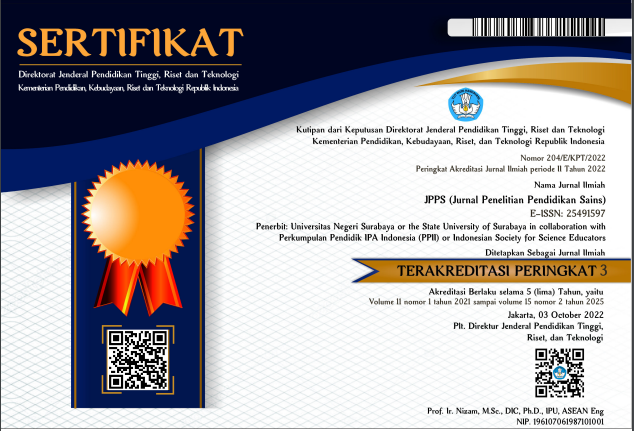EXPLORING CAUSE OF MISCONCEPTION ON REACTION RATE USING 4TMC DIAGNOSTIC TEST INSTRUMENT
DOI:
https://doi.org/10.26740/jpps.v11n1.p1-11Keywords:
Diagnostic test, Four-tier multiple choice , Misconception , Reaction rateAbstract
The research purpose is to explore the cause of misconception on the factors affecting reaction rates using the 4TMC diagnostic test instrument which is reported on the students' conceptions profile, students' misconceptions, and the causes of students' misconceptions. This research was conducted at the class XI science three students senior high school. The result showed that (1) the students’ conceptions profile on the factors affecting reaction rates is 49.77 % misconceptions, 29.55 % did not understand the concept, and 20.68 % understood the concept, (2) the students' misconceptions profile of each sub-material ie misconception of concentration 24.20 %, temperature 21.00 %, surface area 26.03 % and catalyst 28.77 % and there is 5 student (22.73 %) included in the category of high misconceptions, 13 students (59.09 %) medium misconceptions and 4 students (18.18 %) low misconceptions, (3) students’ misconceptions depend on a variety of causes, ie: associative thinking 43.53 %, incomplete reasoning 24.02 %, preconceptions 19.84 %, incorrect intuition 9.96 %, humanistic thinking 2.65 %.
Downloads
References
Cetin, G., Ertepinar, H., & Geban, O. (2015). Effect of conceptual change text-based instruction on ecology, attitudes toward biology and environment. Educational Research and Review, 10(3), 259- 273. http://dx.doi.org/10.5897/ERR2014.2038
Chazbeck, B., & Ayoubi, Z. (2018). Resources used by lebanese secondary physics teachers' for teaching electricity: Types, objectives and factors affecting their selection. Journal of Education in Science, Environment and Health (JESEH), 4(2), 118-128. https://doi.org/10.21891/jeseh.409487
Depdiknas. (2007). Tes diagnostik, direktorat pembinaan sekolah menengah pertama. Jakarta: Direktorat Jenderal Manajemen Pendidikan Dasar dan Menengah
Develi, F., & Namdar, B. (2019). Defining friction force: A proposed solution to a textbook problem. Journal of Education in Science, Environment and Health (JESEH), 5(1), 91-101. https://doi.org/10.21891/jeseh.487399
Fariyani, Q., Rusilowati, A., & Sugianto. (2015). Pengembangan four-tier diagnostic test untuk mengungkap miskonsepsi fisika peserta didik SMA Kelas X. Journal of Innovative Science Education, 4(2), 41-49. https://journal.unnes.ac.id/sju/index.php/jise/article/view/9903
Fernandez-Gonzalez, M. (2013). Idealization in chemistry: Pure substance and laboratory product. Science & Education, 22(7), 1723-1740. https://doi.org/10.1007/s11191-011-9428-2
Fulmer, G W., Chu, H E., Treagust D F., & Neumann K. (2015). Is it harder to know or to reason? Analyzing two-tier science assessment items using the rasch measurement model. Asia-Pacific Science Education, 1(1), 1-16. https://doi.org/10.1186/s41029-015-0005-x
Habiddin, H. A., & Page, E M. (2021). Examining students` ability to solve algorithmic and pictorial style questions in chemical kinetics. International Journal of Science and Mathematics Education, 19(1), 65-85. https://doi.org/10.1007/s10763-019-10037-w
Halim, A., Lestari, D., & Mustafa. (2019). Identification of the causes of misconception on the concept of dynamic electricity. Journal of Physics: Conference Science, 1280(5), 052060. https://doi.org/10.1088/1742-6596/1280/5/052060
Harahap, I. P. P., & Novita, D. (2020). Validitas dan reliabilitas instrumen tes diagnostik four-tier multiple choice (4TMC) pada konsep laju reaksi. Unesa Journal of Chemical Education, 9(2), 222-227. https://ejournal.unesa.ac.id/index.php/journal-of-chemical-education/article/view/32994
Hermita, N., Suhandi, A., Syaodih, E., Samsudin, A., Isjoni., Johan, H., Rosa, F., Setyaningsih, R., Sapriadil, & Safitri, D. (2017). Constructing and implementing a four tier test about static electricity to diagnose pre-service elementary school teacher misconceptions. Journal of Physics: Conference Science, 895, 012167. https://doi.org/10.1088/1742-6596/895/1/012167
Hono, A. S., Yuanita, L., & Suyono. (2014). Penerapan model learning Cycle 7E untuk memprevensi terjadinya miskonsepsi siswa pada konsep reaksi redoks. Jurnal Penelitian Pendidikan Sains, 3(2), 354-360. https://doi.org/10.26740/jpps.v3n2.p354-360.
Ibrahim, M. (2012). Seri pembelajaran inovatif: Konsep, miskonsepsi dan cara pembelajarannya. Surabaya: Unesa University Press
Irawati, R. K. (2019). Pengaruh pemahaman konsep asam basa terhadap konsep hidrolisis garam mata pelajaran kimia SMA Kelas XI. Thabiea: Journal of Natural Science Teaching, 2(1), 1-6. https://doi.org/10.21043/thabiea.v2i1.4090
Jafer, Y. J. (2020). Assessing kuwaiti pre-service science teachers greenhouse effect perceptions and misconceptions. International Journal of Science and Mathematics Education, 18(4), 657-667. https://doi.org/10.1007/s10763-019-09992-1
Kemendikbud. (2016). Permendikbud No 20 Tahun 2016 tentang standar kompetensi lulusan pendidikan dasar dan menengah. Jakarta: Kementerian Pendidikan dan Kebudayaan RI.
Landa, I., Westbroek H., Janssen, F., & van Muijlwijk, J. (2020). Scientific perspectivism in secondary-school chemistry education: Integrating concepts and skills in chemical thinking. Science & Education, 29(1), 1361-1388. https://doi.org/10.1007/s11191-020-00145-3
Ogan-Bekiroglu, F., & Eskin, H. (2012). Examination of the relationship between engagement in scientific argumentation and conceptual knowledge. International Journal of Science and Mathematics Education, 10(6), 1415-1443. https://doi.org/10.1007/s10763-012-9346-z
Picon, R. O., Sevian, H., & Mortimer, E F. (2020). Conceptual profile of substance: representing heterogeneity of thinking in chemistry classrooms. Science & Education, 29(5), 1317-1360. https://doi.org/0.1007/s11191-020-00152-4
Seel, N. M. (Ed). (2012). Encyclopedia of the science of learning. New York: Springer Science.
Slavin, R. E. (2012). Educational psychology: Theory and practice tenth edition. New York: Pearson Education.
Susilaningsih, E., Nuswowati, M., & Natasukma, M. M. (2020). Profile of misconception in particulate level of acid basic subjects. IOP Conference Series: Materials Science and Engineering, 830(4), 042082. https://doi.org/10.1088/1757-899X/830/4/042082
Syahrul, D. A., & Setyarsih, W. (2015). Identifikasi miskonsepsi dan penyebab miskonsepsi siswa dengan three-tier diagnostic test pada materi dinamika rotasi. Jurnal Inovasi Pendidikan Fisika, 4(3), 67-70.
Treagust, D. F. (2006). "Diagnostic Assessment in Science as a Means to Improving Teaching, Learning, and Retention". In UniServe Science Assessment Symposium, Sep 28, 2006, UniServe Science, The University of Sydney.
Wu, S-H., Lai C-L., Hwang, G-J., & Tsai, C-C. (2021). Research trends in technology enhanced chemistry learning: a review of comparative research from 2010 to 2019. Journal of Science Education and Technology, 30(4), 496-510. https://doi.org/10.1007/s10956-020-09894-w
Zajkov, O., Gegovska-Zajkova, S., & Mitrevski, B. (2017). Textbook-caused misconceptions, inconsistencies, and experimental safety risks of a grade 8 physics textbook. International Journal of Science and Mathematics Education, 15(5), 837-852. https://doi.org/10.1007/s10763-016-9715-0
Downloads
Published
How to Cite
Issue
Section
License
Copyright (c) 2021 JPPS (Jurnal Penelitian Pendidikan Sains)

This work is licensed under a Creative Commons Attribution-NonCommercial 4.0 International License.
 Abstract views: 432
,
Abstract views: 432
, PDF Downloads: 408
PDF Downloads: 408












